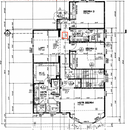Feedback on HRV (or ERV) retrofit plan for my home
It’s a lot of questions below– feel free to comment on any portion. I hope the answers help others as well! Thanks much for any advice– the content on this site is great.
My Goal:
My primary goal is to decrease CO2 levels in closed-door bedrooms in the California SF Bay Area. Running the HVAC fan extra isn’t cutting it, per CO2 meter readings (1000-1400 ppm). (Energy savings is just a nice to have.)
My Draft Plan:
The bedrooms are all on the second floor and have an unconditioned attic above them. Given that the air is fine on the open-plan first floor, I think the retrofit would much easier if I just added a fully ducted system drawing exhausting from bathrooms (and maybe an office) and ducted fresh air into the unconditioned space.
Q1: Tips on an HRV in a (sometimes) hot attic?
I read that an HRV in unconditioned space is inefficient, but if my primary goal is ventilating the upstairs bedrooms, it seems like this is a lot easier than putting it in the basement and running ducts through the first floor to get to the bedrooms. I figure if I just use insulated ducts it’ll be good enough to be worth the tradeoff. (Maybe some units are insulted or I should wrap the unit in insulation except where there’s filter access?)
Q2: Thinking HRV over ERV, right?
We live in the Bay Area which some maps say is “marine”– outside RH around 75 most of the year, with temps 35-100, and we run our A/C at least 6 months a year. Articles I read seems inconclusive, but seems like an HRV might be better?
Q3: Sizing – I use the ASHRAE calculation as the “medium” speed, right?
The ASHRAE calculation says 90 cfm for the house, which would perhaps be 25cfm into the 2 small bedrooms and 40cfm into the larger one or so.
Some HRVs give a range of speeds, like “The Zehnder CA200 exchanges 29 – 118 cfm of air at 0.80” wc. A ComfoAir 200 system is typically designed to exchange about 72 cfm in medium speed.”
So, if I were doing Zehnder ComfoAir, I should probably go up to the CA350, which says 29-218, and 125 cfm at “medium speed,” I think?
Q4: Which models should I look at?
I’ve only looked at Zehnder so far. They have a ComfoAir 350 and a Novus 300 which seem to do the same thing. I’ve heard of the UltimateAir RecoupAerator 200DX (an ERV), the Build Equinox CERV, and various Broan Models.
Q5: Tips on finding an experienced installer in the Bay Area?
If you have tips on finding an experienced installer in the Bay Area, I’m interested. Most HVAC people I spoke with seems to not have much experience with HRV/ERVs. One I talked most to suggested retrofitting it into our existing HVAC air-handler, which seems to be complicated to do correctly, and I don’t see much benefit from in my scenario. My current plan is to try to get a recommendation of the distributor of the system I choose with input from this site.
GBA Detail Library
A collection of one thousand construction details organized by climate and house part










Replies
I'll give your post a bump and suggest reading this article: https://www.greenbuildingadvisor.com/article/hrv-or-erv.
Okay, so I spoke with an Zehnder rep who answered these as follows:
Q1: The Zehnder Q units will shut off above 104 degrees F, so really are better in the basement / conditioned space, but it's not crazy to build a well insulated box around an ERV in the attic, and then run well insulated ducting out of that for a fully ducted system. (In this case I'd buy the ERV from Zehnder and the ducting and registers from a supply house.)
Q2: Zehnder rep pushed me pretty hard towards an ERV, when my reading of the article linked above (thanks Steve) would be that I'd be fine with either. The logic I understood was that ERVs don't change the humidity as much, so I'd be at risk of drying out the place with an HRV during drier times of the year?
Q3: Zehnder rep pushed me much higher, saying that the Q 450 ERV really should be designed to just up 130cfm (even though it can boost much higher, it's louder and less efficient there) and then the Q 600 ERV is the same size and goes up to 200 cfm. He recommended I go with the Q600 and design it for ~180 cfm for the best Co2 and VOC ventilation, even though the ASHRAE calculation says more like 90 cfm. Does that seem a little overkill?
Q4: He said that the Novus 300 is no longer sold, and that the Zehnder ComfoAir is obviously the best. :) Still open to other opinions on an alternative to look at.
Q5: I got a list of HVAC installers in the Bay Area that have at least indicated an interest in Zehnder equipment... so that's a start!
Would definitely appreciate additional thoughts on any of this. Thanks again!
Any luck finding an installer?